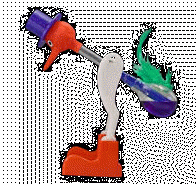|
Title |
Description |
|
Task 1 - Lumpy light... |
Your teacher will show you
this presentation, and explain the implications for our wave
model of light... |
|
Task 1b - Light as a particle |
Our new ideas about the model of light requires
us to think about some key conepts in a slightly different way.
Your teacher will ask you to share your ideas about how to
define the following properties for a photon:
• frequency
• wavelength
• amplitude |
|
Task 2a - Light as
a particle |
We need to be able to
calculate the energy carried by a photon, and also to calculate
the number of rotations a photon undergoes along a given
path, in order to find the phase of the photon when it
arrives at its destination.
These notes help explain how to do this. When you are
happy you understand, answer the questions at the bottom of each
page. |
|
Task 2b - Light as a particle |
Answer
these questions (Q20E), which look at the energy carried by
a photon and the number of photons emitted from a source, and
these questions (Q10S) which look at the number of rotations
a photon undergoes whilst travelling along a path. |
|
Task 3 - A quantum view of diffraction... |
Lets think about the double slit experiment we
looked at recently. We need to be able to explain the
pattern we observe in terms of the interaction between the
"particles" (photons) of light. We should surely see
something like
this - but we know this is not the case!
Let's consider slowing the stream of light down,
until there is only one photon travelling through at a time, and
see how this affects our ideas... Your teacher will
explain to you a rather surprising conclusion we draw from our
observations...! |
|
Task 4a - Many paths... |
Look at
this simulation, which shows how the different paths
followed by a photon affect the probability of arrival. |
|
Task 4b - Many paths... |
Suggested exam questions:
June 08 Q11 - last section (2 marks)
June 09 Q5 (Section A, 3 marks) |
|
Task X |
A |
|
Task X |
A |
|
Task X |
A |
|
Finding Planck's constant |
1. Remind the person next to you:
• what
the current-voltage graph looks like for a diode.
•
The regions of the EM spectrum, in order.
•
The regions of the visible spectrum, in order.
2. Your teacher will explain how our quantum
model of light requires us to look at an LED in a slightly
different way. Measure the striking voltage for each of
the LEDs in the array. Record your results in a table.
3. Stick
these notes in your exercise book, next to your results, and
follow the instructions to find Planck's constant.
Suggested exam question:
June 09 |
|
LED as a quantum system |
Suggested exam question(s):
June 09 Q9 (Section B, 11 marks) |
|
|
|
|
The Photoelectric effect |
The photoelectric effect is an important piece of evidence which
supports the photon model of light. Your teacher will show
you this
simulation, and explain why the effect cannot be
accounted for using the wave model.
When you are happy you understand, try
completing
this comprehension exercise (Q50C). |
|
|
|
|
|
|
|
Double slit experiment for electrons |
Look at
this website. |
|
The Structure of the Atom |
Read about how Rutherford's
famous alpha-scattering experiment helped us to develop our
primitive nuclear model of
the
structure of the atom. |
|
Rutherford Scattering |
See a simulation of
Rutherford Scattering (alternative link
here) |
|
Models of the Hydrogen Atom |
Look at different
models of the Hydrogen
atom have evolved, from the
Thomson's simple plum pudding model, to the accepted quantum model we
use today. |
|
Atomic Ionisation and Excitation
- Gas Discharge Lamps |
A simulation to
show how
Fluorescent Lights / Gas Discharge Lamps
work. |
|
Atomic Ionisation
and Excitation |
Learn about the atomic
processes behind absorption and emission spectra with
this presentation. |
|
|
Quantum Wave
Interference (java) |
|
The Photoelectric Effect |
The Photoelectric Effect
(java) |
|
Blackbody Radiation |
This simulation shows the
intensity of radiation as a function of frequency for a perfect
'black body'. The idea of
black body radiation
was influential in the development of the quantum (photon-based)
model of light. |
|
Electron Spin |
This simulation illustrates
the Stern-Gerlach experiment, an example of
the strange property of electron 'spin'. |
|
|
|

